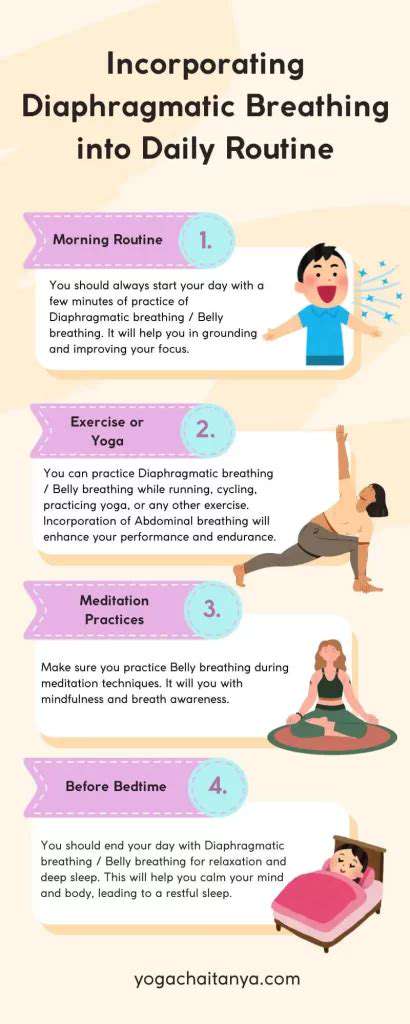How Diaphragmatic Breathing Helps Alleviate Anxiety
Anxiety and Shallow Breathing
Anxiety hijacks our breathing, turning it into quick, shallow sips of air that leave us perpetually breathless. This chest breathing triggers a vicious cycle—the less oxygen we get, the more panicked we feel, which makes breathing even shallower. It's like running on a treadmill that keeps speeding up, with no off switch in sight.
Diaphragmatic breathing breaks this cycle by flooding the system with oxygen. Imagine dousing a fire—the flames of anxiety shrink back as deep, measured breaths restore balance to a frazzled nervous system.
Diaphragmatic Breathing Techniques
Let's make this practical. Lie down and bend your knees—this position naturally encourages diaphragmatic engagement. Place one hand on your chest, the other on your belly. Breathe in through your nose, feeling only the lower hand rise. Exhale through pursed lips like you're blowing out birthday candles, watching your belly sink.
For seated practice, imagine your spine as a string pulling you upward. The hand on your stomach should do all the moving—your chest remains as still as a lake at dawn. Consistency transforms this from exercise to instinct, making it your body's default in times of stress.
Benefits of Diaphragmatic Breathing for Anxiety Relief
The magic of diaphragmatic breathing lies in its dual action—it's both physical reset and mental refuge. By engaging the diaphragm, we flick the switch from fight or flight to rest and digest. Heart rate slows, blood pressure drops, and stress hormones retreat like shadows at sunrise.
This practice also trains the mind to focus on the present—each breath becomes a meditation, pulling us away from anxious what ifs to the solid ground of right now. It's not just breathing; it's reclaiming control over runaway thoughts.
How Does Diaphragmatic Breathing Reduce Anxiety?
Understanding Diaphragmatic Breathing
Diaphragmatic breathing isn't just deep breathing—it's targeted breathing. While shallow breaths barely skim the surface of your lungs, diaphragmatic breaths fill them from bottom to top like pouring water into a glass. This maximizes oxygen exchange while efficiently removing carbon dioxide, creating optimal conditions for both body and mind to thrive.
The Impact on the Nervous System
Our nervous system has two gears: the gas pedal (sympathetic) and brakes (parasympathetic). Anxiety stomps on the gas until we're redlining. Diaphragmatic breathing gently applies the brakes, slowing everything down. It's the difference between screeching to a halt and gliding smoothly to rest—the destination is the same, but the journey feels completely different.
Slowing Down the Breath, Calming the Mind
Anxiety breathes in staccato bursts; calm breathes in flowing sentences. By consciously elongating each breath—inhale for 4 counts, exhale for 6—we rewrite anxiety's frantic script. The breath becomes a metronome, setting a slower, steadier tempo for both body and mind to follow.
Promoting Relaxation and Reducing Stress Hormones
Deep diaphragmatic breaths trigger a biochemical cascade. Stress hormones like cortisol retreat while feel-good chemicals like endorphins advance. It's like sending in peacekeepers to calm hormonal riots—the body's chemistry shifts from under siege to safe harbor.
Improving Body Awareness and Mindfulness
Each diaphragmatic breath is a homing beacon, calling scattered attention back to the body. Anxiety lives in imagined futures; the breath anchors us in the tangible present. This isn't just breathing—it's training the mind to dwell in reality rather than catastrophe.
Integrating Diaphragmatic Breathing into Daily Life
Think of diaphragmatic breathing as mental hygiene—as essential as brushing teeth, but for your nervous system. Waiting in line? Breathe. Stuck in traffic? Breathe. These micro-practices build resilience, creating a buffer against stress before it escalates to anxiety.
Incorporating Diaphragmatic Breathing into Your Daily Life

Understanding the Diaphragm
This unsung hero of respiration works tirelessly beneath our notice. When we learn to partner with it consciously, ordinary breathing becomes extraordinary healing. The diaphragm is nature's built-in stress reliever—we just need to remember how to use it properly.
Benefits of Diaphragmatic Breathing
The perks extend far beyond anxiety relief. Better sleep, improved digestion, enhanced focus—it's like upgrading your body's operating system. For respiratory conditions, it can be particularly transformative, helping to retrain dysfunctional breathing patterns.
Techniques for Diaphragmatic Breathing
Start simple: five minutes upon waking, five before sleeping. Feel your abdomen rise like a balloon inflating, fall like a gentle sigh. Quality beats quantity—ten conscious breaths outweigh hours of unaware breathing.
Practical Applications in Daily Life
Turn mundane moments into mini-retreats. Email loading? Breathe. Microwave counting down? Breathe. These pockets of practice accumulate into profound change, rewiring your stress response one breath at a time.
Connecting Breathing to Mindfulness
The breath is the bridge between mind and body. Diaphragmatic breathing makes that bridge wide and sturdy. This isn't just stress reduction—it's self-discovery, a way to become fluent in your body's language.
Diaphragmatic Breathing for Relaxation and Stress Reduction
When stress strikes, most people forget they carry this portable calm button. Three deep diaphragmatic breaths can reset an escalating panic like rebooting a frozen computer—simple, but powerfully effective.
Potential Challenges and Considerations
Initially, it might feel awkward—like wearing someone else's shoes. That's normal. Be patient; you're retraining a lifetime of breathing habits. Those with health concerns should consult a professional, but for most, this practice is safer than sitting too long.